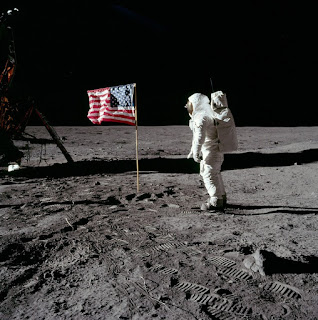The Summer of ’69: A Snapshot of America
By Elspeth Sweatman
Looking back, the summer of 1969 seems idyllic. A hamburger cost 10 cents, a gallon of gas, 35. But throughout those dog days, a sense of revolution was sweeping the nation. On the streets, beehive hairdos were giving way to tie-dye shirts and bell-bottom jeans. On the airwaves, girl groups were competing with rock ’n’ roll and protest anthems. On television, Bonanza was followed by footage of the Vietnam War. Like Pearl and Alison in A Walk on the Moon, many Americans felt they were on the cusp of radical change. Here’s a snapshot of America in that life-changing year.
 |
| Astronaut Buzz Aldrin salutes the US flag. Photo by Neil Armstrong/NASA. Courtesy Wikimedia Commons. |
On June 27, Life magazine published photos of the 241 American soldiers killed in Vietnam during a one-week period. The public response was immediate, visceral, and divided. By 1969, US armed forces had been in Vietnam for almost 15 years. Although most Americans initially viewed this intervention as necessary in the fight against communism, as the body count rose, many lost confidence in the US government. Anti-war protests grew. Young men burned their draft cards. Anti–Vietnam War sentiment would grow until US troops withdrew in 1975.
One Small Step
At 7:56 p.m. PST on July 21, Apollo 11 astronaut Neil Armstrong uttered the iconic line, “That’s one small step for a man, one giant leap for mankind,” as he stepped onto the surface of the moon. He was joined a few minutes later by fellow crew member Buzz Aldrin. Together, they planted the US flag and a plaque reading, “We came in peace for all mankind.” It was the culmination of a decade of dreams, successes, and failures for American space exploration. Nationwide, 120 million people tuned in to watch the moon landing on their television sets.
 |
| Opening ceremony at Woodstock. August 14, 1969. Photo by Mark Goff. Courtesy Wikimedia Commons. |
For three hot August days, more than 400,000 people crowded into an upstate New York dairy farm to hear their favorite musicians: Janis Joplin, the Who, Jimi Hendrix, Joan Baez, Jefferson Airplane, and 26 other acts. The Woodstock Music & Art Fair would become a defining moment, not just in music but in American culture. It instantly became a shining example of social harmony, and an illustration of the power of the anti-war movement that would gain traction in the 1970s. In 2017, the Woodstock site was added to the National Register of Historic Places.
Women's Movement
Inspired by anti-war protests, female rock musicians, and books such as Betty Friedan’s The Feminine Mystique (1963), many women in the 1960s were reexamining their lives and joining the fight for freedom and equality. For some women, such as Pearl in A Walk on the Moon, this meant ditching tight 1950s girdles in favor of loose-fitting clothing and reassessing their dreams and desires. For others, such as Pearl’s daughter Alison, it meant joining the second-wave feminist movement. All over the country, women were marching for equal rights in all aspects of society.
A Walk on the Moon runs through July 1 at A.C.T.’s Geary Theater. Click here to purchase tickets. Want to learn more about the history behind the musical? Order a copy of Words on Plays, A.C.T.'s in-depth performance guide series.

